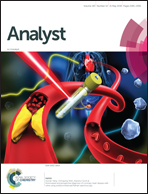Intracellular endogenous glutathione detection and imaging by a simple and sensitive spectroscopic off–on probe†
Abstract
Glutathione (GSH) exhibits many cellular functions in human pathologies. A sensitive and simple method capable of assaying GSH would be useful to understand the mechanism of GSH-related diseases. In this study, a new colorimetric and fluorescent off–on probe, 3-oxo-3H-phenoxazin-7-ylthiophene-2-carboxylate, is constructed, synthesized and applied to determine fluctuations in intracellular GSH levels selectively and sensitively. The latent fluorescent probe is designed by reacting resorufin with thiophenecarboxylate and shows high sensitivity (LOD 8.9 × 10−7 M) and off–on fluorescent response to GSH over other different physiological species in pH 7.4 buffer solutions. A new reaction mechanism based on the cut-through of thiophenecarboxylate in the probe by GSH is confirmed via the HPLC (high performance liquid chromatography) and MS (mass spectrometry) analytical methods. Moreover, the probe is successfully applied to image GSH in A549 cells and indicates fluctuations in GSH levels under the stimulation of chemicals and drugs, which is verified by the investigation of the cell lysate with a commonly used commercial assay kit. As a result, it is feasible to monitor the levels of GSH in biosamples.



 Please wait while we load your content...
Please wait while we load your content...